Military & Veterans Life
Cover Story: Marking an Anniversary for Women Pilots

Today we mark an anniversary for the advancement of women in the military, particularly in air combat for over 30 years.
Women have been flying planes in the military for decades, yet they have faced persistent obstacles as it relates to combat service. The Women's Armed Services Integration Act of 1948 prohibited women from flying combat missions, effectively barring them from a crucial aspect of military aviation.
The Gulf War in 1991 marked a turning point when over 40,000 women served in critical aviation roles. This shift in perception culminated in a historic vote by the United States Senate on July 31, 1991, allowing women to fly combat aircrafts. Jeannie M. Leavitt made history as the first female fighter pilot in the U.S. Air Force, taking to the skies in the F-15E Strike Eagle in 1993.

Leavitt's career spanned 25 years, during which she shattered barriers, logged over 3,000 flight hours, and rose to the rank of Major General. She initially sought to avoid media attention, preferring to focus solely on her passion for flying fighter jets. However, she eventually embraced her role as a trailblazer, recognizing the impact she had on inspiring future generations of women to pursue their dreams in military aviation.
Leavitt's achievements inspired a wave of women to enter military aviation, leading to significant milestones such as the first air-to-air kill by an unnamed female Navy pilot in the Middle East just two months ago. These accomplishments stand as a testament to Leavitt's legacy and the progress made towards gender equality in military combat roles.
Over a decade after Leavitt's barrier-breaking achievement, First Lt. Vernice Armour (left) emerged as the first female African-American combat pilot in the Department of Defense and the first African-American female naval aviator in the Marine Corps. Armour's journey was marked by resilience and a commitment to serving as a role model for young people, regardless of gender or race.
"I realize that I’m a role model, and there’s more pressure with that because I do want to set the right example for young people out there, whether they are a boy or a girl, or whether they are black or white … I do want to be that role model. I relish it," Armour said in a Camp Pendleton publication soon after her tour serving in Iraq.
In tribute to Leavitt's groundbreaking achievements, The University of Texas at Austin President Jay Hartzell honored her at their commencement, recognizing her persistence, resilience, and preparedness in seizing unforeseen opportunities.
“Maj. Gen. Leavitt broke much more than the sound barrier when she first took to the skies as a fighter pilot,” Hartzell said.
As many women have made significant strides in military aviation, others have made the ultimate sacrifice. Cornelia Fort, a member of the Women Airforce Service Pilots (WASP), became the first female American pilot to die while on active duty in 1943. Fort's dedication to flying was symbolized in the 1999 PBS documentary “Fly Girls.”
"I can't say exactly why I fly, but I know why as I've never known anything in my life," Fort was quoted as saying in "Fly Girls." "I know that in dignity and self-sufficiency and in the pride of skill."
The stories of Jeannie M. Leavitt, Cornelia Fort, and Vernice Armour serve as powerful reminders of the courage, determination, and resilience of women in military aviation. Their contributions have paved the way for future generations of women to embrace their dreams and excel in combat roles, leaving an indelible mark on the history of military aviation.




